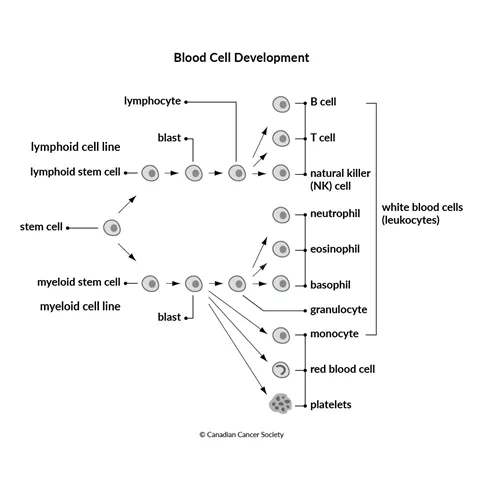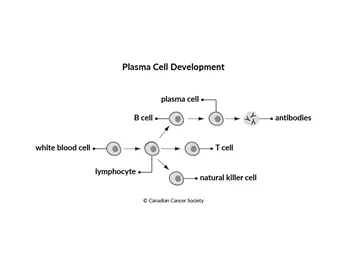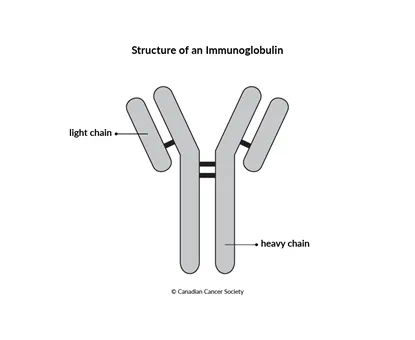The plasma cells
Multiple myeloma is a cancer of the plasma cells, a type of white blood cell that
makes
Plasma cells are found in bone marrow, where blood cells are made. Normal bone marrow contains few plasma cells. A person with multiple myeloma often has many abnormal plasma cells (myeloma cells) in the bone marrow.
Myeloma cells can form tumours in bones called plasmacytomas. If there is only one tumour in the bone, it’s called a solitary plasmacytoma. When there are many plasmacytomas in the bones, the condition is called multiple myeloma. Plasmacytomas can also form outside of the bones and are called extramedullary plasmacytomas.
Blood and blood cells
Blood has liquid and solid parts. The liquid part of blood is plasma, and the solid part are cells. Plasma is made up of water and the many substances that are dissolved in it, such as proteins, minerals and sugars.
All blood cells develop from stem cells. Stem cells develop within 1 of 2 cell lines, the lymphoid cell line or the myeloid cell line. In both cell lines, the stem cells become blasts, which are immature cells. The blasts mature into 3 types of blood cells:
- red blood cells
- white blood cells
- platelets

Each type of blood cell has a specific role.
Red blood cells carry oxygen from the lungs to the rest of the body and return carbon dioxide to the lungs.
Platelets help the blood to clot when a blood vessel is damaged.
White blood cells help prevent and fight infection by destroying bacteria, viruses and other foreign cells or substances.
White blood cells
White blood cells are an important part of the
Lymphocytes
Lymphocytes are a type of white blood cell that fights viruses, bacteria, foreign substances and abnormal cells, including cancer cells. There are 3 types of lymphocytes:
- T cells recognize antigens and activate B cells. They can also kill viruses and cancer cells.
- B cells develop into plasma cells that make antibodies to fight infection. Multiple myeloma starts in B cells.
- Natural killer (NK) cells attack any foreign cells, including cancer cells.
Neutrophils and monocytes
Neutrophils and monocytes are white blood cells that fight infection by ingesting (eating) or engulfing (surrounding) foreign cells, such as bacteria.
Eosinophils
Eosinophils are a type of white blood cell that helps control inflammation and allergic reactions. They attack and destroy certain parasites.
Basophils
Basophils are a type of white blood cell that plays a role in certain allergic reactions.

Antigens, antibodies and plasma cells
Antigens are located on the surface of bacteria, viruses, cancer cells and other foreign invaders. An antigen triggers the immune system, specifically plasma cells, to produce antibodies against an antigen.
Antibodies, or immunoglobulins, are special proteins that fight infection and defend the body against harmful foreign invaders. They circulate in the blood and attach to specific antigens on the surface of bacteria, viruses or other foreign substances.
Antibodies are specific to a particular antigen. When the immune system identifies a new antigen, a plasma cell makes a new antibody. Once a plasma cell responds to an antigen, it will only make antibodies for that antigen.
In multiple myeloma, B cells don’t work properly and make many abnormal plasma cells (called myeloma cells). Normally, plasma cells make up about 2% to 3% of the cells in bone marrow. In people with multiple myeloma, abnormal plasma cells make up at least 10% of the cells in the bone marrow. They crowd out (take the space of) other types of blood cells, such as red blood cells, other white blood cells and platelets, so there aren’t enough of these cells to do their jobs. As a result, a person can become anemic (because they don’t have enough red blood cells), bleed easily (because they don’t have enough platelets) and get more infections than normal (because they don’t have enough white blood cells).
Immunoglobulins
Immunoglobulins (Ig) are Y-shaped protein molecules, called antibodies, that are made by plasma cells. Immunoglobulin is made up of 4 parts called chains. There are 2 light chains and 2 heavy chains that are attached to each other by chemical bonds.
There are 5 types of immunoglobulins – IgG, IgA, IgM, IgD and IgE. Each of the 5 types of immunoglobulins is named after the type of heavy chain that it contains.
- light chains – kappa, lambda
- heavy chains – G, A, M, D, E

When B cells develop into abnormal plasma cells (myeloma cells), they make large amounts of one type of immunoglobulin (called a monoclonal immunoglobulin) and release it into the blood. This monoclonal immunoglobulin is also called an M-protein or paraprotein. An M-protein can be measured in the blood and urine. If a lab test finds an M-protein, there is a problem with the plasma cells.
Sometimes the myeloma cells don’t make whole immunoglobulins and only release the light chains into the blood. These light chains aren’t attached to heavy chains (called free light chains). When free light chains are found in the urine, they are also called Bence-Jones proteins.
Bones and bone marrow
Bones are the structures that make up most of the skeleton. Bone is either hard and dense (called compact bone) or arranged like a honeycomb (called spongy bone). Bone marrow is the soft, spongy substance in the centre of a bone where blood cells are made. In adults, the bone marrow that makes most blood cells (called active bone marrow) is found in the pelvic and shoulder bones, spine (vertebrae), ribs, breastbone (sternum) and skull. Plasmacytomas usually develop in these areas where bone marrow is active.
There are 2 main types of bone cells that work together to break down old or damaged bone and build new bone.
Osteoblasts make bone.
Osteoclasts break down and remodel bone as bones grow or if there is stress on the skeleton. Osteoclasts also help to control blood calcium levels as they release calcium into the blood as bone is broken down.
Bone destruction
When osteoclasts work faster than osteoblasts, bone becomes weak. When osteoblasts work faster than osteoclasts, bone gets bigger and stronger. In normal adult bone, the activity of osteoblasts and osteoclasts is balanced so your bones don’t weaken or keep getting bigger.
In multiple myeloma, myeloma cells stop osteoblasts from making new bone. Myeloma cells also make osteoclasts work harder to break down bone, so bone gets weaker. Osteoclasts also make chemicals called cytokines that stimulate myeloma cells to grow and divide.
The combination of myeloma cells collecting in the bone marrow and osteoclasts breaking down bone causes it to become weak and thin. Areas of bone weakness can be seen on an x-ray as thin, dark lines called fractures or dark circular spots called osteolytic lesions. Osteolytic lesions may mean that there is a plasmacytoma or other disease of the bone. Weakened bone may break under normal stresses like walking, lifting and coughing. Thinning of the bone can also lead to osteoporosis.
Your trusted source for accurate cancer information
With support from readers like you, we can continue to provide the highest quality cancer information for over 100 types of cancer.
We’re here to ensure easy access to accurate cancer information for you and the millions of people who visit this website every year. But we can’t do it alone.
Every donation helps fund reliable cancer information, compassionate support services and the most promising research. Please give today because every contribution counts. Thank you.
